2011 TOYOTA FJ CRUISER gas type
[x] Cancel search: gas typePage 72 of 528
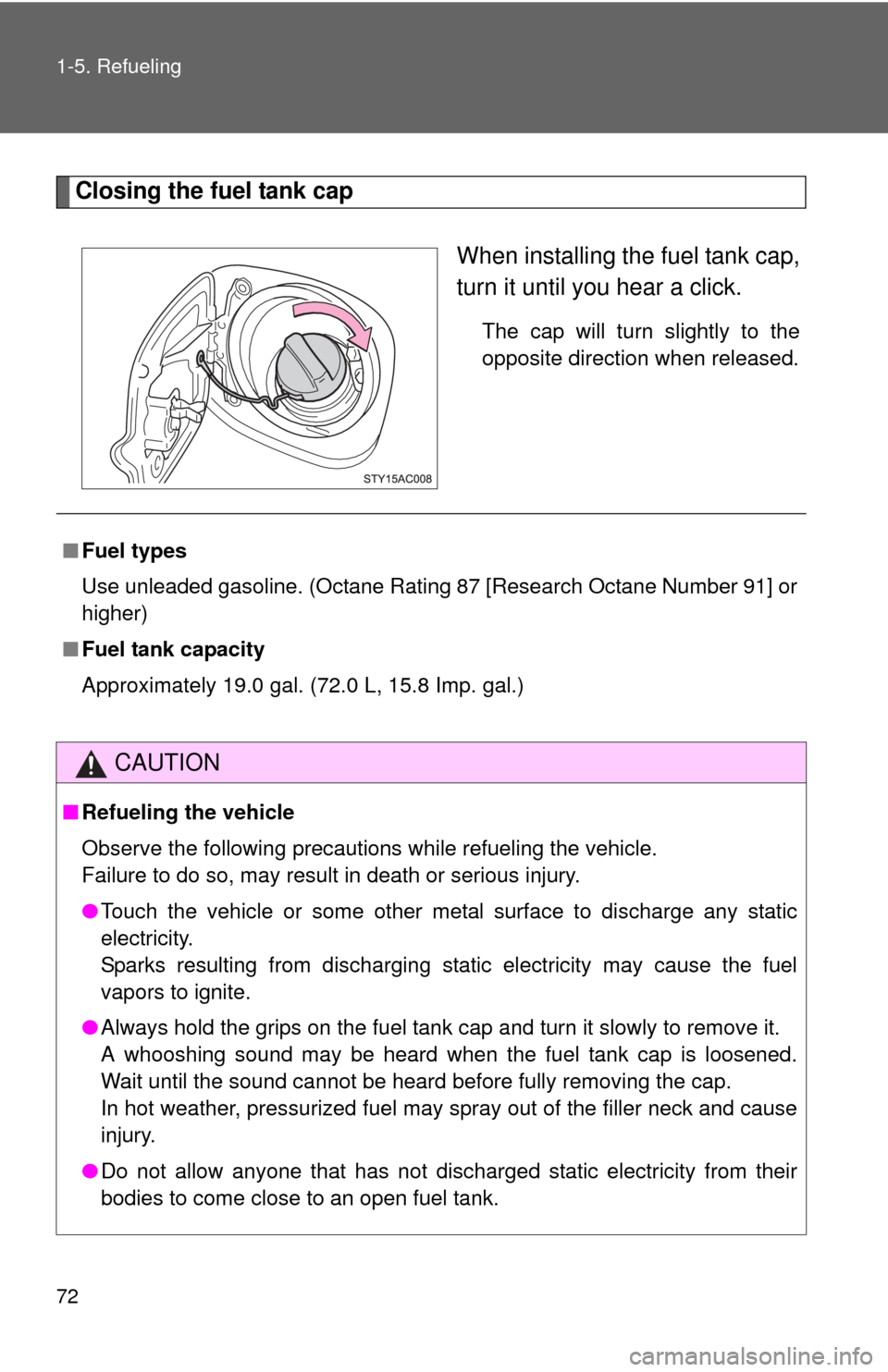
72 1-5. Refueling
Closing the fuel tank capWhen installing the fuel tank cap,
turn it until you hear a click.
The cap will turn slightly to the
opposite direction when released.
■Fuel types
Use unleaded gasoline. (Octane Rating 87 [Research Octane Number 91] or
higher)
■ Fuel tank capacity
Approximately 19.0 gal. (72.0 L, 15.8 Imp. gal.)
CAUTION
■Refueling the vehicle
Observe the following precautions while refueling the vehicle.
Failure to do so, may result in death or serious injury.
●Touch the vehicle or some other metal surface to discharge any static
electricity.
Sparks resulting from discharging static electricity may cause the fuel
vapors to ignite.
● Always hold the grips on the fuel tank cap and turn it slowly to remove it.
A whooshing sound may be heard when the fuel tank cap is loosened.
Wait until the sound cannot be heard before fully removing the cap.
In hot weather, pressurized fuel may spray out of the filler neck and cause
injury.
● Do not allow anyone that has not discharged static electricity from their
bodies to come close to an open fuel tank.
Page 81 of 528
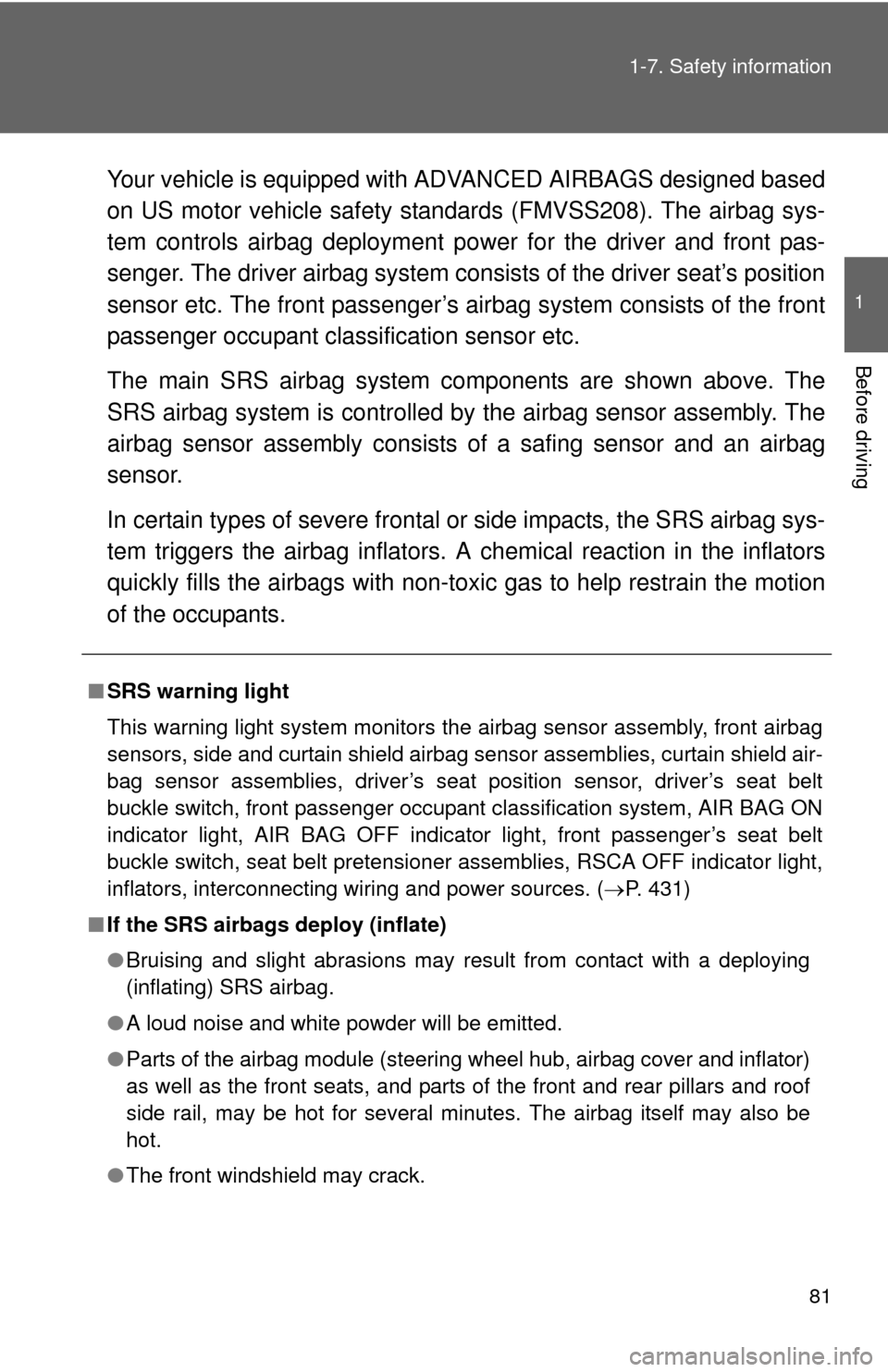
81
1-7. Safety information
1
Before driving
Your vehicle is equipped with
ADVANCED AIRBAGS designed based
on US motor vehicle safety standards (FMVSS208). The airbag sys-
tem controls airbag deployment po wer for the driver and front pas-
senger. The driver airbag system consists of the driver seat’s position
sensor etc. The front passenger’s airbag system consists of the front
passenger occupant classification sensor etc.
The main SRS airbag system components are shown above. The
SRS airbag system is controlled by the airbag sensor assembly. The
airbag sensor assembly consists of a safing sensor and an airbag
sensor.
In certain types of severe frontal or side impacts, the SRS airbag sys-
tem triggers the airbag inflators. A chemical reaction in the inflators
quickly fills the airbags with non-toxic gas to help rest rain the motion
of the occupants.
■ SRS warning light
This warning light system monitors the airbag sensor assembly, front airbag
sensors, side and curtain shield airbag sensor assemblies, curtain shield air-
bag sensor assemblies, driver’s seat position sensor, driver’s seat belt
buckle switch, front passenger occupant classification system, AIR BAG ON
indicator light, AIR BAG OFF indicator light, front passenger’s seat belt
buckle switch, seat belt pretensioner assemblies, RSCA OFF indicator light,
inflators, interconnecting wiring and power sources. ( P. 431)
■ If the SRS airbags deploy (inflate)
●Bruising and slight abrasions may result from contact with a deploying
(inflating) SRS airbag.
● A loud noise and white powder will be emitted.
● Parts of the airbag module (steering wheel hub, airbag cover and inflator)
as well as the front seats, and parts of the front and rear pillars and roof
side rail, may be hot for several minutes. The airbag itself may also be
hot.
● The front windshield may crack.
Page 470 of 528
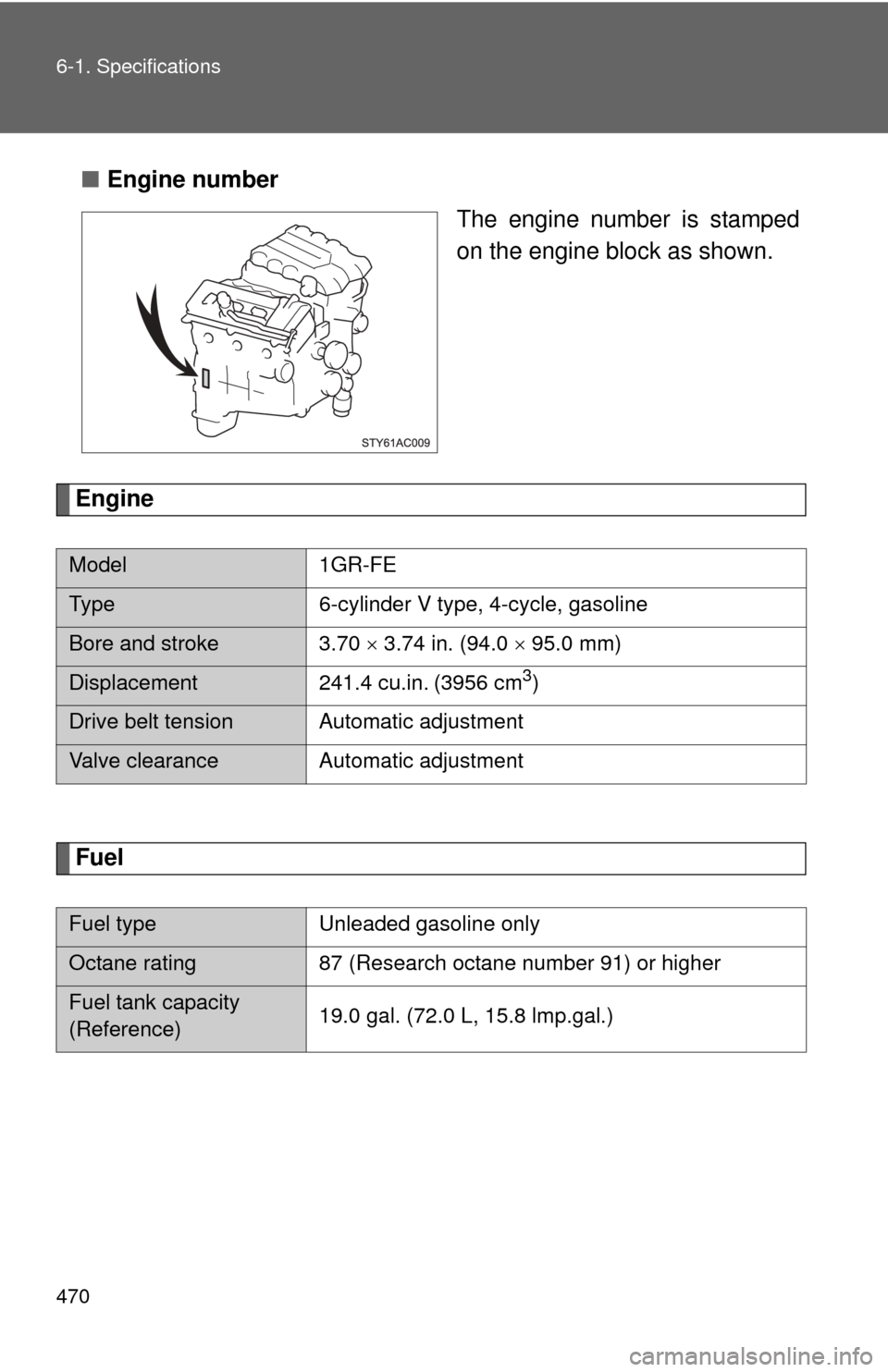
470 6-1. Specifications
■Engine number
The engine number is stamped
on the engine block as shown.
Engine
Fuel
Model1GR-FE
Type 6-cylinder V type, 4-cycle, gasoline
Bore and stroke 3.70 3.74 in. (94.0 95.0 mm)
Displacement 241.4 cu.in. (3956 cm3)
Drive belt tension Automatic adjustment
Valve clearance Automatic adjustment
Fuel type Unleaded gasoline only
Octane rating 87 (Research octane number 91) or higher
Fuel tank capacity
(Reference) 19.0 gal. (72.0 L, 15.8 lmp.gal.)
Page 480 of 528
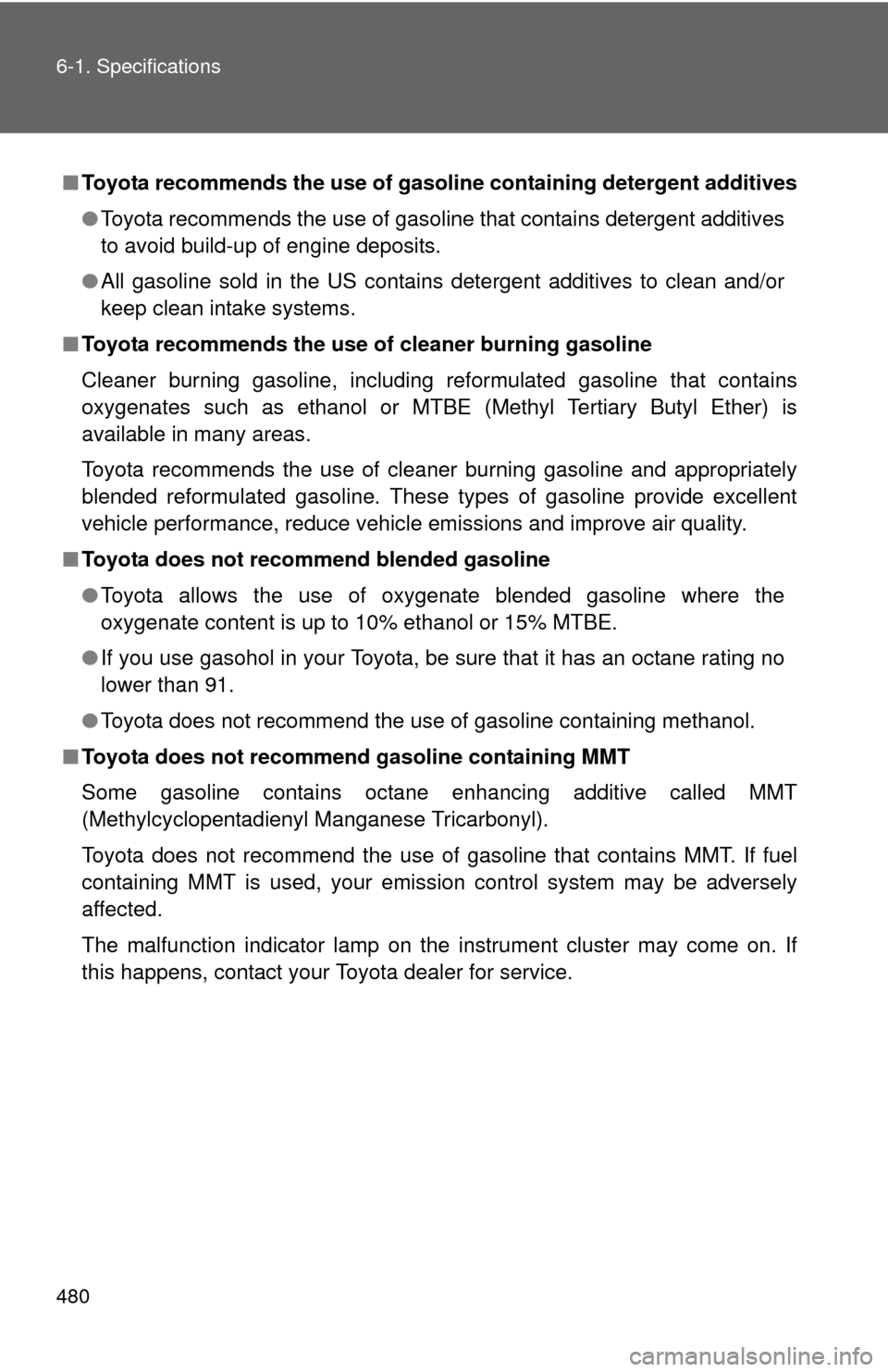
480 6-1. Specifications
■Toyota recommends the use of gaso line containing detergent additives
● Toyota recommends the use of gasoline that contains detergent additives
to avoid build-up of engine deposits.
● All gasoline sold in the US contains detergent additives to clean and/or
keep clean intake systems.
■ Toyota recommends the use of cleaner burning gasoline
Cleaner burning gasoline, including reformulated gasoline that contains
oxygenates such as ethanol or MTBE (Methyl Tertiary Butyl Ether) is
available in many areas.
Toyota recommends the use of cleaner burning gasoline and appropriately
blended reformulated gasoline. These types of gasoline provide excellent
vehicle performance, reduce vehicle emissions and improve air quality.
■ Toyota does not recomm end blended gasoline
● Toyota allows the use of oxygenate blended gasoline where the
oxygenate content is up to 10% ethanol or 15% MTBE.
● If you use gasohol in your Toyota, be sure that it has an octane rating no
lower than 91.
● Toyota does not recommend the use of gasoline containing methanol.
■ Toyota does not recommen d gasoline containing MMT
Some gasoline contains octane enhancing additive called MMT
(Methylcyclopentadienyl Manganese Tricarbonyl).
Toyota does not recommend the use of gasoline that contains MMT. If fuel
containing MMT is used, your emission control system may be adversely
affected.
The malfunction indicator lamp on the instrument cluster may come on. If
this happens, contact your Toyota dealer for service.
Page 481 of 528
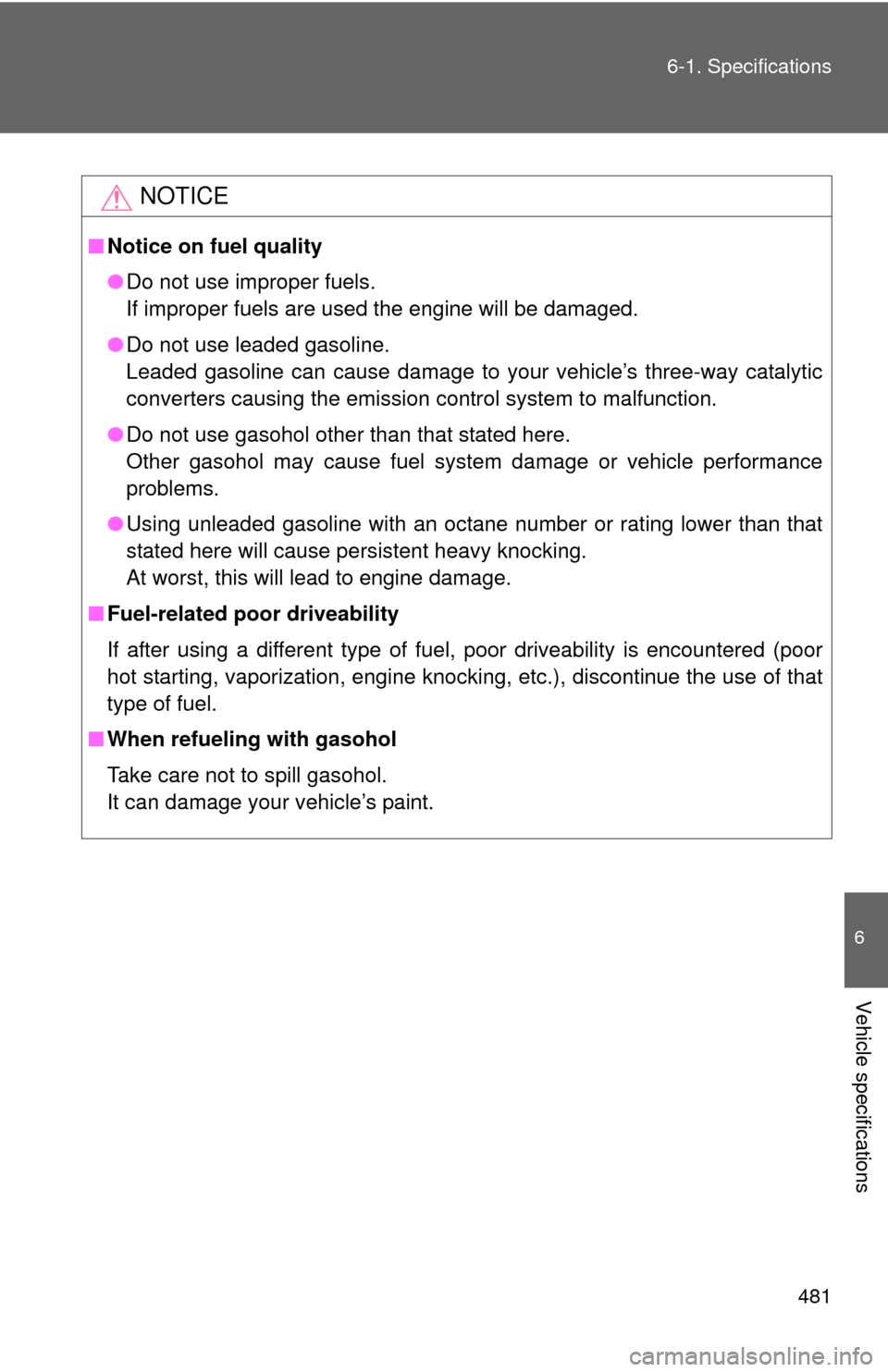
481
6-1. Specifications
6
Vehicle specifications
NOTICE
■
Notice on fuel quality
●Do not use improper fuels.
If improper fuels are used the engine will be damaged.
● Do not use leaded gasoline.
Leaded gasoline can cause damage to your vehicle’s three-way catalytic
converters causing the emission control system to malfunction.
● Do not use gasohol other than that stated here.
Other gasohol may cause fuel system damage or vehicle performance
problems.
● Using unleaded gasoline with an octane number or rating lower than that
stated here will cause persistent heavy knocking.
At worst, this will lead to engine damage.
■ Fuel-related poor driveability
If after using a different type of fuel, poor driveability is encountered (poor
hot starting, vaporization, engine knocking, etc.), discontinue the use of that
type of fuel.
■ When refueling with gasohol
Take care not to spill gasohol.
It can damage your vehicle’s paint.
Page 517 of 528
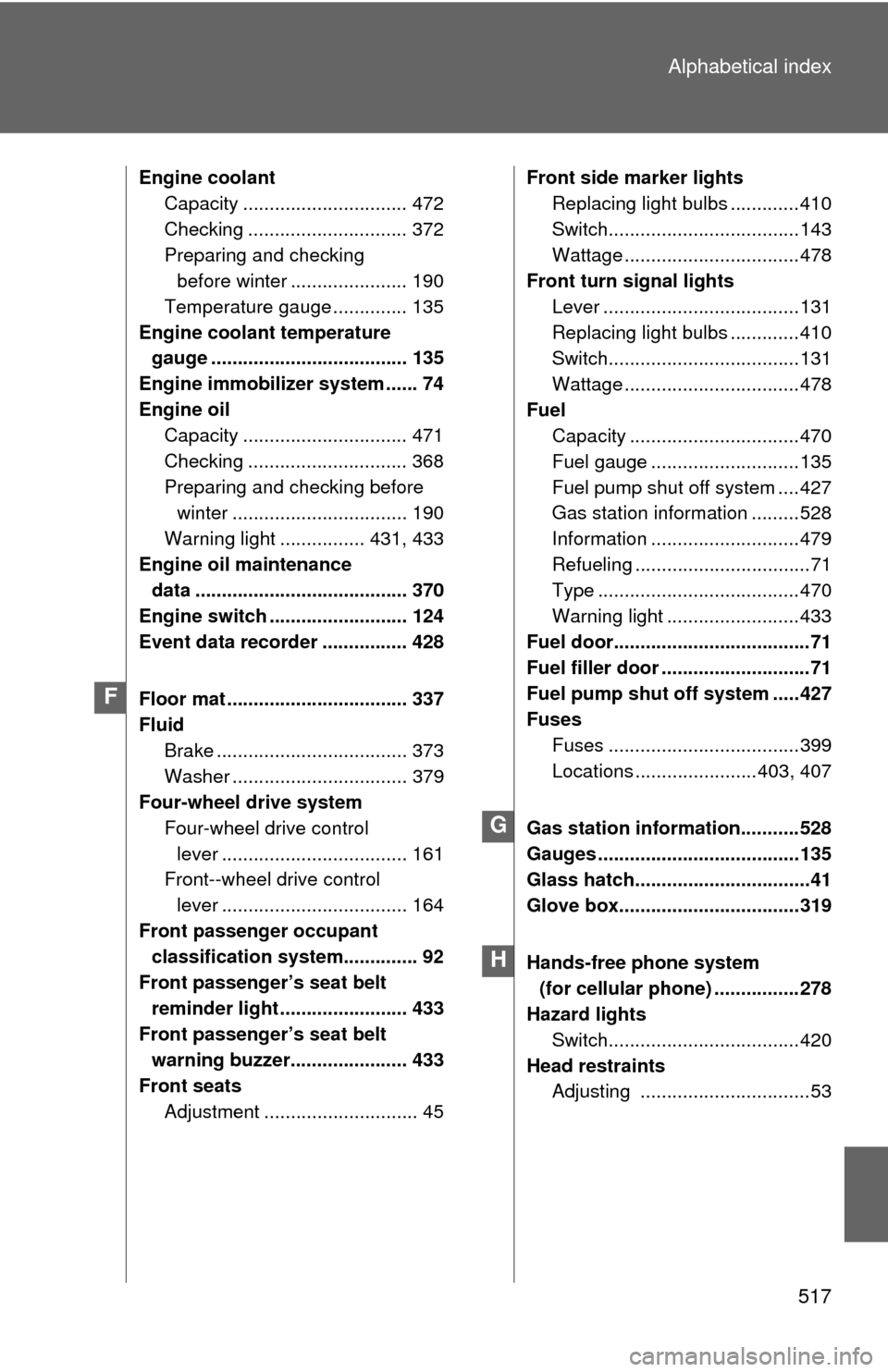
517
Alphabetical index
Engine coolant
Capacity ............................... 472
Checking .............................. 372
Preparing and checking before winter ...................... 190
Temperature gauge .............. 135
Engine coolan t temperature
gauge ..................................... 135
Engine immobilizer system ...... 74
Engine oil Capacity ............................... 471
Checking .............................. 368
Preparing and checking before winter ................................. 190
Warning light ................ 431, 433
Engine oil maintenance data ........................................ 370
Engine switch .......................... 124
Event data recorder ................ 428
Floor mat .................................. 337
Fluid Brake .................................... 373
Washer ................................. 379
Four-wheel drive system
Four-wheel drive control lever ................................... 161
Front--wheel drive control
lever ................................... 164
Front passenger occupant classification system.............. 92
Front passenger’s seat belt reminder light ........................ 433
Front passenger’s seat belt
warning buzzer...................... 433
Front seats Adjustment ............................. 45 Front side marker lights
Replacing light bulbs .............410
Switch....................................143
Wattage .................................478
Front turn signal lights
Lever .....................................131
Replacing light bulbs .............410
Switch....................................131
Wattage .................................478
Fuel Capacity ................................470
Fuel gauge ............................135
Fuel pump shut off system ....427
Gas station information .........528
Information ............................479
Refueling .................................71
Type ......................................470
Warning light .........................433
Fuel door.....................................71
Fuel filler door ............................71
Fuel pump shut off system .....427
Fuses Fuses ....................................399
Locations .......................403, 407
Gas station information...........528
Gauges ......................................135
Glass hatch.................................41
Glove box..................................319
Hands-free phone system (for cellular phone) ................278
Hazard lights
Switch....................................420
Head restraints Adjusting ................................53
F
G
H
Page 528 of 528
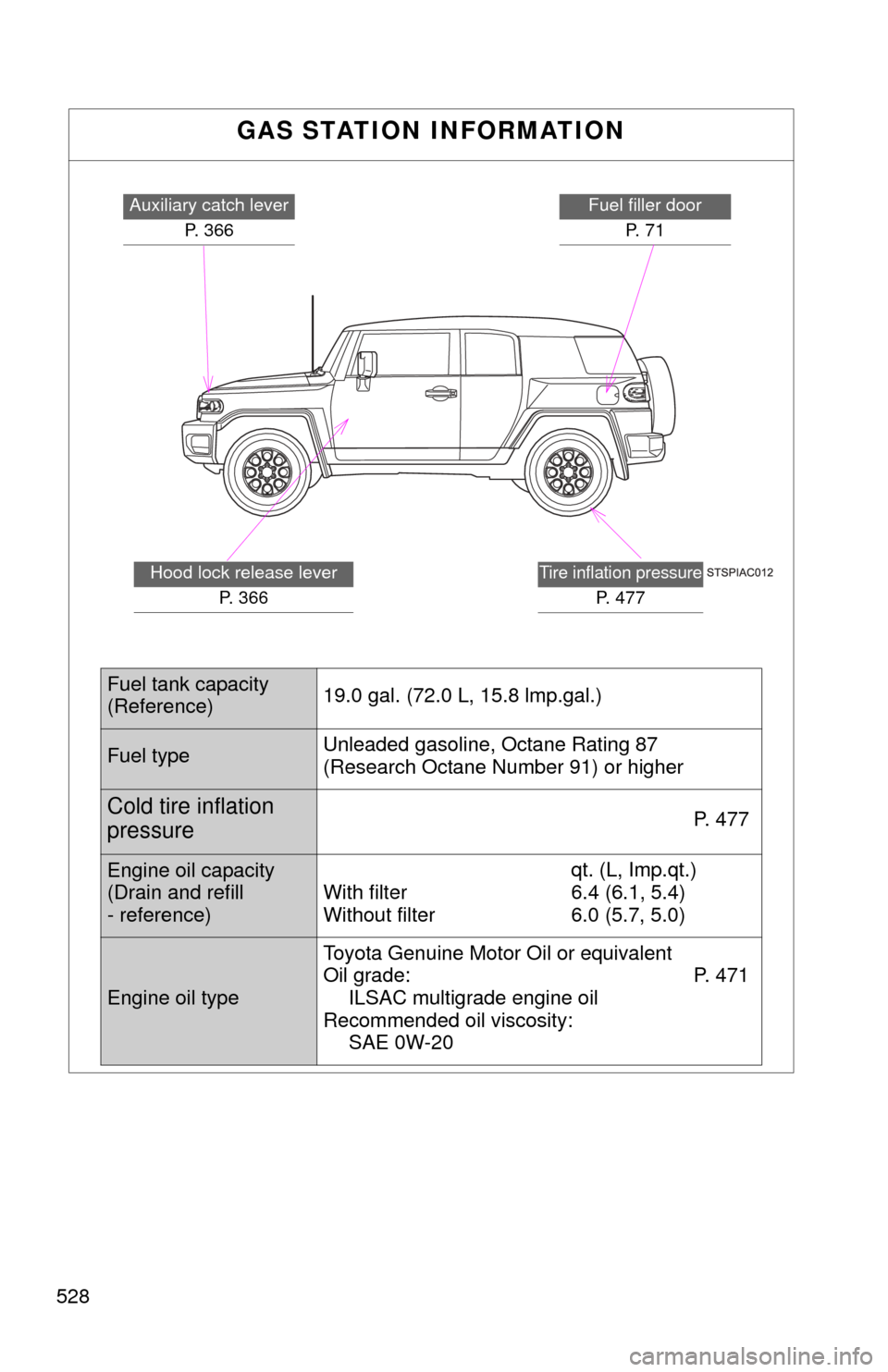
528
GAS STATION INFORMATION
Auxiliary catch leverP. 366Fuel filler doorP. 7 1
Tire inflation pressure
P. 4 7 7
Hood lock release lever P. 366
Fuel tank capacity
(Reference) 19.0 gal. (72.0 L, 15.8 lmp.gal.)
Fuel typeUnleaded gasoline, Octane Rating 87
(Research Octane Number 91) or higher
Cold tire inflation
pressureP. 4 7 7
Engine oil capacity
(Drain and refill
- reference) qt. (L, Imp.qt.)
With filter 6.4 (6.1, 5.4)
Without filter 6.0 (5.7, 5.0)
Engine oil type Toyota Genuine Motor Oil or equivalent
Oil grade: P. 471
ILSAC multigrade engine oil
Recommended oil viscosity: SAE 0W-20